Drift back with me now to the fall of 1964 in Kansas City…
The country was slowly recovering from the assassination of John F. Kennedy. We were well into the presidential campaign between Lyndon Baines Johnson and conservative stalwart Barry Goldwater. Ilus Davis has just defeated Dutton Brookfield a few months earlier to become Mayor of Kansas City, succeeding the legendary H. Roe Bartle.
If you were a kid, your radio was most likely tuned to WHB 710 AM listening to new British Invaders such as The Beatles (although Billboard’s #1 song in August of 1964 was actually Dean Martin’s, “Everybody Loves Somebody”).
I was entering the 7th grade at a new school and had struck up a tenuous friendship with another kid who thought he knew all the ropes. He rode a bus downtown to Bill Neal’s Chrysler Plymouth and bought a pair of tickets to an upcoming wrestling match, but not just any wrestling match; World Heavyweight Champion Lou Thesz against Dick the Bruiser. He invited me to join him and I did.
Coming up on 50 years now I can still feel the calling.
First a little professional wrestling history.
In the roughly 20 year period from the end of World War II to the mid 1960’s, a strong argument could be made that professional wrestling in the country was controlled largely by a group of Midwestern promoters and that Kansas City was ground zero.
Wrestling “territories” arose in the 1930’s when New York promoter Jack Curley was looking to have a young wrestling phenom by the name of Jim Londos travel across the country to wrestle against local challengers.
Curley thought his best chance for financial success was to allow local promoters the opportunity to share in the gate so he looked to deal with existing individuals in major cities across the South and Midwest.
In the 1920’s and 1930’s professional wrestling had a bit more of a “legitimate” pedigree than it does today. And the three most recognizable athletes in the nation during that timeframe were Babe Ruth, Jack Dempsey, and Ed “Strangler” Lewis, the latter a professional wrestler.
By the time the war ended, just about every major city had a wrestling promoter and the Midwest was especially influential. In 1948, a group of Midwestern promoters met in Waterloo, Iowa to structure and formalize the National Wrestling Alliance. Already loosely partnered, the group’s goal was to allow local promoters to control the matches and gate within their “territories” while also establishing a recognized national champion who would travel to all the markets to help create interest and promote local talent.
“Pinkie” George from Des Moines was the driving force but the group also included representatives from Chicago, Detroit, Minneapolis, Columbus, Omaha, St. Louis (Sam Muchnik), and Kansas City (George Simpson).
The men chose Orville Brown from Kansas City as their first heavyweight champion. Interestingly for locals, the recognized champion here before Brown was “Sonny” Myers. Sonny would become a regular in the Kansas City/St. Joe market and later became the Buchannan County, Missouri sheriff.
From that point forward, until the mid 1960’s the NWA was the most powerful organization in professional wrestling. But some splintering began in the next decade.
Back East, Vincent J. McMahon (father of the current WWE CEO Vincent K. McMahon) formed the World Wide Wrestling Federation and in the early 1960’s named Bruno Sammartino as its champion (Sammartino celebrated his 79th birthday Monday).
In Minneapolis, the American Wrestling Association was formed and Verne Gagne was its titleholder. Minneapolis was also where Kansas City guy Handsome Harley Race made a name for himself as one half of the championship tag team partnership with Larry Hennig.
In California, the Worldwide Wrestling Associates had its belts worn by stars such as as The Destroyer, Fred Blassie, and Pedro Morales.
And movement by individual wrestlers became less common, but there were still national stars who crossed the territories, wrestlers like Cowboy Bob Ellis, Bobo Brazil, The Sheik, Ernie Ladd (a former Kansas City Chief) and Gene Kiniski (who defeated Thesz in 1966 to take the NWA crown). All of whom made it to Kansas City over the years.
George Simpson was the lead promoter in Kansas City from the mid 1940’s until the early 1960’s when he was joined by wrestlers Bob Geigel and Pat O’Connor in matchmaking the local cards.
Gust Karras in St. Joseph Missouri was also a major player in the regional market. Both Geigel and O’Connor had impressive amateur wrestling careers before going professional. O’Connor, from New Zealand, was a noted international wrestler and after turning pro, briefly held the NWA title. Geigel attended the University of Iowa where he won conference championships and placed 3rd in the 1948 NCAA wrestling championships. Geigel would later become the head of the NWA.
So from the mid 1960’s until around 1980 this territorial format continued but the advent of pay-per-view and cable television spelled the end.
The younger Vince McMahons’ vision for the industry created a new paradigm and when he hired Hulk Hogan away from the NWA in 1979 and the rest, as they say, is history.
OK, back to the fall of 1964…
The headline match that night was Dick the Bruiser against Lou Thesz for the NWA Heavyweight Championship. The Bruiser (Richard Afflis) was just a few years removed from an NFL career with the Green Bay Packers.
A year earlier, an infamous fight between the Bruiser and rough, tough Detroit Lions lineman Alex Karras went down in Karras’ bar. It took most of Karras’ staff and a number of Detroit policemen to subdue the Bruiser.
At the age of 35, Afflis looked as if he could still play NFL football without a helmet or pads.
Thesz on the other hand had just come out of retirement at the age of 46 to regain the title from Buddy Rogers and looked to me like he was closer to 60.
No way in my mind could Thesz could handle the Bruiser, but handle him he did.
The match must have been fixed – and obviously it was – but even if it wasn’t, the outcome probably would have been the same. Thesz was very old school and clean in terms of following the rules, but he was also a “Hooker.”
In wrestling a “hooker” is a professional wrestler who has the ability to win any match at any time with the application of an actual submission hold. And while Bruiser was nothing more than a barroom brawler, Thesz was a scientific wrestler trained by Ed “Strangler” Lewis.
That thrilling match got a young teenager hooked on professional wrestling and for the next several years, I was at Memorial Hall every Thursday night I could go and at WDAF-TV studios every Saturday at noon to watch the television matches.
And if I could get the aluminum foil on my TV’s rabbit ears just right I could even watch the Saturday night matches that Gust Karras held up in St. Joe.
I regularly watched wrestlers like Johnny Valentine, the Missouri Mauler, The Mongolian Stomper, the tag team of Geigel and Dutch Savage (and later Bob Brown), The Viking, The Ox, The Butcher and his manager Dandy Jack, Ron Reed, Ronnie Etchison, Sonny Myers, Pat O’Connor, Tor Kamata & Oki Shikina, etc.
Of course it wasn’t complete without ring announcer Bill Kersten (later the mayor of Liberty) and referee Richard Moody.
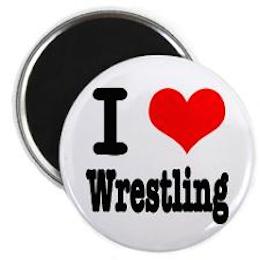 Twin, little-old-lady wrestling fans Mertie and Gertie Hite were regulars, pummeling the bad guys with their purses from their front row seats when the “heels” got out of the ring.
Twin, little-old-lady wrestling fans Mertie and Gertie Hite were regulars, pummeling the bad guys with their purses from their front row seats when the “heels” got out of the ring.
I called out and got faced down by Bulldog Bob Brown one time outside the Channel 4 studios; another time I remember dipping my wrestling program in blood to make a more memorable souvenir; I rummaged through the trash outside the local wrestling promoter’s offices searching for souvenirs and found evidence of matches that has been fixed.
You name it, I did it all.
Those were good times and great memories for sure.

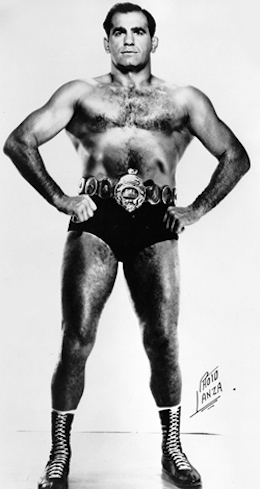
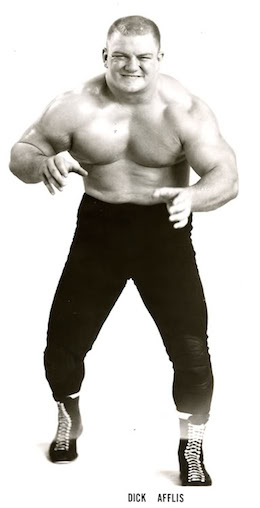
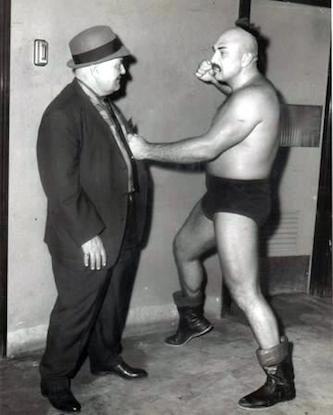
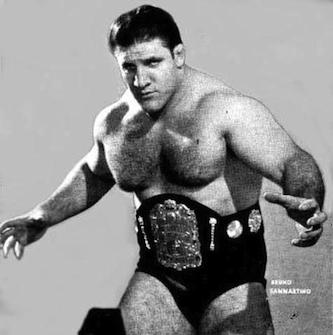
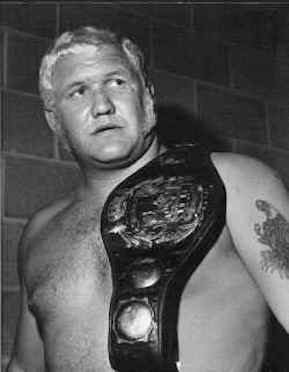
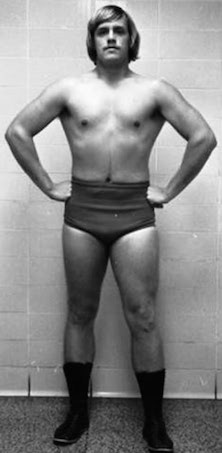
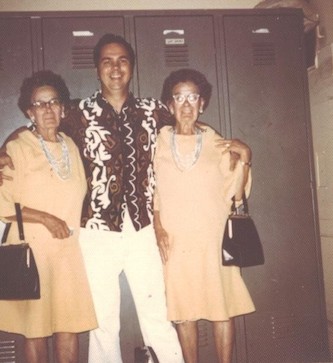
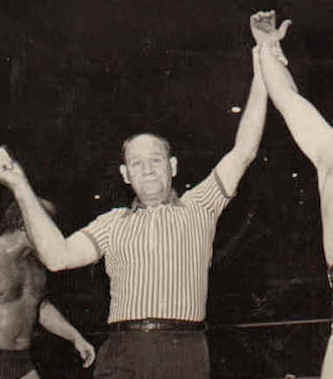

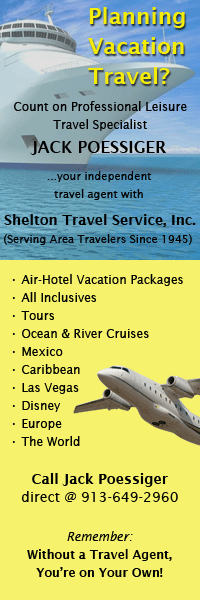
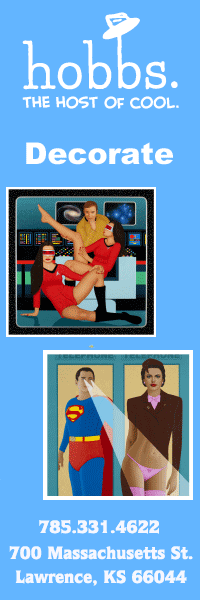
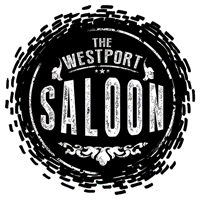

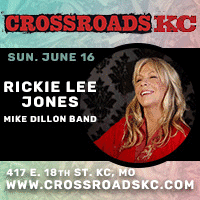
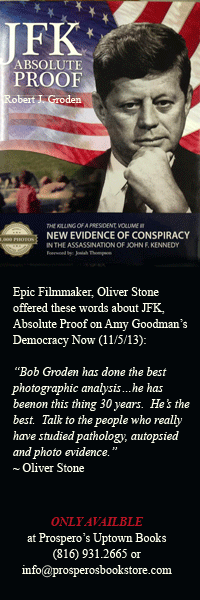
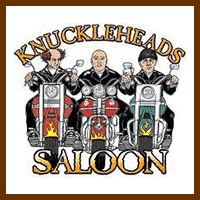

Nice read. I remember those Saturday night matches in St. Joe very well. Bulldog Bob Brown vs. Mike George, the car dealer, are most vivid to me now, for some reason.
Biggest letdown was when Rufus R. Railroad Jones advertised on the program at matches at Pittsburg State offering an employment opportunity and it turned out to be a gig selling Amway.
Great job on the writing. Kudos, sir!
Keep writin’ ’em Stomper!!
I love old wrasslin’ stories!
I’d like to see the guy who wore the Indian Headdress try that today. He’d have to wrassle the protestors to get to the ring…..Was his name Danny little bear or am I confusing him with someone else?
Dead on the money Mark.
Chief Jay Strongbow. This video is hilarious.
http://www.youtube.com/watch?v=EuSc7ylPsqM
By the way, he was Italian.
Good story Stomper. A guy who “dips programs in blood” and “digs through the trash” for evidence and memorabilia, is exceptionally American.
Every month or so, my friend’s dad would host a poker party across the street from where I lived. Wasn’t unusual for BD Bob Brown, Harley Race, Bob Geigel, et al to be in attendance. My friend and I played “beer bitch” to these wrestling icons. Pretty cool. I run into “The Major” in Liberty every so often at our watering hole. Can’t let him go without one good, “Hellooooooooo wrestling fans!” Bill is a good dude with more stories than you could shake a stick out.
Nice read, Stomper. Good times. Good times.
I enjoyed the hell out of this article. Good stuff.
Also, I thought I would respond to this:”Id like to see the guy who wore the Indian Headdress try that today. He’d have to wrassle the protestors to get to the ring…..”
Even today the WWE uses ethnic stereotypes to create characters for the wrestlers. Currently they have an Irish wrestler whose gimmick is mainly, “I’m Irish! I’m gonna fight then have a pint.” I remember in maybe 2006 they had three very famous and respected lucha wrestlers come to the ring on riding lawn mowers and call themselves the “Mexicools.”
That level of stereotyping probably wouldn’t fly today but the WWE just signed a very well known Japanese wrestler and there was plenty of concern by fans that he was going to get turned into a silly comedy act based off of racist stereotypes. One stereotype that I am pretty sure was invented in wrestling was, “A Samoan’s head is as hard as a coconut.” If there is one thing that stays consistent in wrestling it’s that you never headbutt a Samoan wrestler.
Awesome history lesson.
We even went to the Missouri State Fair back in 1970 or 1971 to see Rufus R. Jones grapple. Good times.
I used to see Texas Bob at all the gun & knife shows that used to held a t the governors expo building. He had a security company or something, and was always standing guard at the door. He would always get a sheepish little grin when an old fan would call him out, or tell their kids about the golden age of wrestling in KC. Cool guy.
Harley Race ruined 2 peoples lives in a boating accident several years ago, leaving a couple pretty much screwed up for life. It was an accident, but Harley was at fault.
Hate to be that guy, but Hogan went to New Japan Pro Wrestling and AWA after his initial run with the WWF in 79 and 1980. He left because he wanted to film the scene in Rocky 3, and Vincent J. McMahon (the father of the probably more well-known Vincent K. McMahon) did not want him to.
He was actually a bad guy (heel) in his initial WWE run, being managed by Freddie Blassie and feuding with Andre the Giant.
He ended up in the AWA in 1981, and after Gagne refused to put the belt on him even though he was mega over as a good guy in the AWA in a feud with Nick Bockwinkle, he ended up heading back to the WWF in 1983.
This was a big turning point for a young Vincent K. McMahon who had bought the WWF from his dad in 1982. Not only did it put a huge dent in the AWA with the purchase of Hogan, he also signed Bobby Heenan and Gene Okerlund among others, it led to the rise of Hulkamania, Rock N’ Wrestling, and the first big wrestling boom in America in quite a while. Then, as they say, the rest is history…
Undoubtedly you guys noticed how relatively UN BUFF Hogan is in this photo.
Obviously it was prior to him using illegal steroids to muscle up. In fact, he may be the poster child for that use. Which helped make the WWE (then the WWF) but once they got major busted for that, they outlawed it.
The somewhat funny story I read in doing my editing research was that Hogan was doing a radio or TV interview one day with Lou Ferrigno – The Incredible Hulk actor – when he noticed that he was way more buff than “The Hulk.”
Which got him to thinking and resulted in him choosing “Hulk” for his wrestling name.
Even when roided he had bird legs.
Good stuff!
I used to usher part-time at Memorial Hall in KCK – I remember the little old ladies .. blacks would sit in their own section in the balconies..
my fave Dick the Bruiser story was during a post-match interview, Dick didn’t like the question – took the mic away from the interviewer, and wrapped the wire around his throat to fake-strangle him. Hilarious.
The perceptive KCC readers probably already suspect this but the tenuous friendship I began that fall and my host for the Bruiser/Thesz match was none other than our esteemed admin.
The friendship remains tenuous five decades later.
Thanks for outing me, Stomps.
And would you mind sharing your definition of “tenuous”?
Meaning very uncertain. In its’ early stages.
Meant no disrespect , admin. But glad I got your attention.
GREAT story, Stomper! As you know, I’m NOT a rasslin fan but, man, what a great piece of history and story line! Well done, do this more often! I’m a fan.
Whew, thanks. I don’t need any more dirt out on me. As a 65 year old on social security, I just can’t afford it.
Hey Stomper, Wilson…
Why don’t you guys get a room?
Because its Hetro Pride Week and I dont CARE who knows!!
Professional wrestling is the only sport I bet on, Woody Allen once said.
We probably ran into each other at Memorial Hall during the mid-60s. Ernie Ladd made his debut after the trade from the Chargers. He was a heel but the crowd reacted to his being a Chief. He was very perplexed early in the match. He had never been a face before.
Municipal Auditorium had monthly matches from the St Louis promoter. Bruno and Kaminski both wrestled The Stomper there.
Perhaps the greatest night was the final Texas Death Match between The Mongolian Stomper and Cowbody Bob Ellis. They had fought singles and tag team matches with blood flying. The larger seating of the Auditorium allowed almost triple the crowd.
Blood flew, the crowd went wild and rioted with the match being halted (curfew maybe) and no decision but a bloody affair for sure.
The next day, Monday, the MO Athletic Commision met and passed a resolution saying the two could never have a match against each other again. So they became a popular tag team.
Mrs. Sanger was a teacher at NEHS and a ‘rasslin’ fan and was there. Describing each blow with the prose of a poet.
Yet my band’s drummer was there too and waiting for a ride home from his dad who ran the restaurant in the Muelbach.
In came The Stomber and Cowboy, laughing and joking. Couple of bandaids on their foreheads. It was as bad as finding out the was no Santa Clause.
When the WWE was still the WWWF and the territories were still running, Killer Kowalski told how the matches were using scripted until a title match. Then it was real as a great deal of money came with the belt.
The Sandman from ECW taught me how to suplex a person. He went to hs with Bill Mass and some of my friends.
Thanks Orphan, if you were at Memorial Hall in the mid-60’s then we definitely crossed paths. And, yes, the matches at Municipal Auditorium were special events as it normally meant that a big name from out of town was on the card and a larger venue was needed to accomodate the crowd. I recall doing homework for my latin class there one night between the matches. Still can’t believe my parents agreed to that deal. Think we had dinner at the A&W next to the Time to Read bookstore on 12th St. just west of Main that night. Probably 12 or 13 years old. Sound familiar, admin ???
Yeah, except the homework part. LOL
Used to eat chili in that joint below the A&W.
Mom & her friend had been going since Red Barber was champ. So they took me to St Joe.
Some farm boy was outraged at Bob Brown’s conduct and he went to Fist City with him. Brown was shocked for about a minute and then put him down and chicken-winged him.
The sight of the police laughing at him when he cried he wanted to press charges was priceless.
Going to sent this to my friend, Micheal Tearson, in Philadelphia. He was a great DJ and we spent many evening discussing wrestling between music acts at The Main Point.
Metro Sports has an excellent documentary it did on KC wrestling back in the day. Can’t recall the name but it’s on periodically.
Chris Gough from Metro Sports put it together about 5 years ago. Called ” K.C. On The Mat; The History of Professional Wrestling in Kansas City”. You’re correct, it was a great piece.
Thanks Newbaum Turk.
was at a party at rufus r. jone’s house (pink house) on prospect.
guy was laying around watching cartoons while the rest of his family
ate chicken and grits.
he was friends and had retired already..but cool old dude.
kinda like wislun.
Thanks Harley. No piece is complete or credible at KCC without a comment from you. I was starting to feel ignored.
Wow…great memories.
I was a HUGE pro wrestling fan in my adolescent days, even though I only got to see a couple of the Thursday night cards at Memorial Hall in person. My favorite was Danny Little Bear, who’d enter the ring in full Indian headdress. Rufus R. Jones was his tag team partner for awhile. Didn’t he also run a restaurant in Midtown?
I also liked Lou Thesz, even though you could tell he was over the hill by then. When he lost the title to Gene Kiniski I was bummed out for days.
My older brother had his own brush with these guys, in a way. As a teenager he worked in the emergency room at St. Margaret’s Hospital in KCK. Whenever a match at Memorial Hall got out of hand, he’d help patch them up.
A few years later I got to meet The Viking when he came into an all-night grocery store I worked at in Roeland Park. Nice guy.
By the way, anybody know if that Metro Sports documentary is still available for sale?
I recall the territorial system still extending into the 1980s, but diminishing into almost nothing as the decade progressed. The Kansas City territory was still putting out a quality product until around 1985/86, but not so great thereafter until it finally folded in the years after. For example, for a brief period in 1984, could there ever have been a more frightening threesome for a 14-year-old to behold than M.E.B. (Man Eating Beast/Rick Link), Triple 6 (666/Jim Starr), and their manager, Shiek Abdullah Ali Hassan The Great (Jack Krueger)? Fond memories, if also a little scary at the time.
What wrestler was it that held the North American Tagteam Title back in 69 70,was it Killer Karl Kox or Killer Cox im confused?
I was living in Auburn in the 1960s. I remember the Stomper & Cowboy Bob Ellis defeating the 2 Bobs, probably 1966. I was probably 9 years old.
Excellent flashback, Wildman